Printer Toner vs. Ink: What Is the Difference Between Toner & Ink?
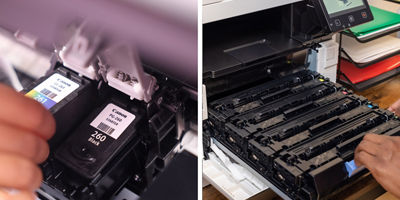
Printers use either ink or toner to create words and images on a page. While some people use the words ink and toner interchangeably, there is a difference between ink and toner. In fact, the contrast between printer toner vs. ink is as different as dry vs. wet. That’s because when you print with toner, you’re using a dry powder. Whereas when you print with ink, you’re printing with liquid. Toner is generally used in a laser printer (and in photocopiers) and ink is used in an inkjet printer. Ink and toner both have their own benefits and limitations depending on what type of products you’re printing and at what volume and speed. Read on to learn more about ink vs. toner.
What is Printer Toner and When to Choose It
Have you ever wondered, “is toner the same as ink?” Many people assume that all printers use ink and that toner is just another word for printer ink. But there’s actually a difference between toner and ink. And if you’re using a laser printer, you won’t be using ink at all – you’ll using something called toner.
So, what is toner in a printer? Toner is a fine powder that’s usually made up of teeny tiny pieces of plastic. Toner can be black, or it can be different colors. Toner can offer a few advantages: some people choose it because they plan to print a high volume of documents and want to do so quickly. In addition, some people love the reliability of toner. It can last a long time, and the output quality tends to be consistent.

Printer Compatibility
Be sure and check the manual that came with your printer to confirm that it uses printer toner vs ink. Toner is primarily used in laser printers and photocopiers. An example of a popular printer that uses toner is the Canon Color imageCLASS MF753Cdw. This all-in-one wireless1 laser printer can print, copy, scan and fax. It’s speedy, printing up to 35 pages per minute2. With auto two-sided printing, it can automatically print with toner on both sides of the page, and you can choose to print in black and white or color.
Printing Process
When you click “print” your computer or device gives your printer instructions on what to do. In essence, the laser within the laser printer draws out the letters and images you want to print, and the toner—which is kind of like powdered ink—brings your work to life on the page. For a more technical description visit our page on How Laser Printers Work.
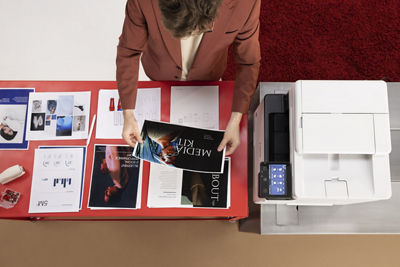
Speed
Speed is one of the key benefits of a laser printer. As an example, the Canon imageCLASS LBP247dw is a wireless laser printer that can print up to 42 black-and-white pages per minute2 (it’s a monochrome printer, meaning it only prints in black and white, not in color). That’s three times faster than some inkjet printers! For high-volume jobs, a printer that uses toner may be the best choice.
Durability
Because toner powder is dry, and it’s fused to the page using heat, it may not have the same risk of smudging that ink might have when using an inkjet printer. In addition, toner may resist moisture better than ink on the page. Overall, some toner cartridges may last longer than some ink cartridges. Whereas an ink cartridge may dry out, toner doesn’t bear that same risk. A toner cartridge can still work well, even if it’s gone unused for a fair amount of time.
Ideal Use Cases
If you’re printing frequently and you value precision and durability in your work, toner is an excellent choice, whether you work in a large office, a small office or even a home office. For high-volume needs, when comparing printers for speed and quality, toner often comes out ahead.
Whether you need ink or toner, and to learn more about Canon’s printer and toner products visit Black & Color Toners for Canon Laser Printers.
Want to learn more about some of the top choices for laser printers? Here are two popular offerings from Canon:

Canon Color imageCLASS MF656Cdw
- Wireless1 4-in-1 (Print | Copy | Scan | Fax)
- Print up to 22 Pages Per Minute (BW and Color)2
- Uses Toner 067 / 067 High-Capacity Toner
- 250-sheet Standard Cassette, 1-sheet Multipurpose Tray, 50-sheet Automatic Document Feeder
- Auto 2-sided Printing, One-pass 2-sided Scanning
- ENERGY STAR®3, EPEAT Silver
- 3 Year Warranty4

- Wireless1 Single Function (Print Only)
- Print up to 42 pages per minute2
- Uses Toner 070 / 070 High-Capacity Toner
- 250-sheet Standard Cassette, 100-sheet Multipurpose Tray, Expandable Paper Capacity up to 900-sheets using optional Paper Cassette AH-1
- Auto 2-sided Printing
- Large 5" Color Touchscreen for easy navigation
- Quick First Print Out Time (FPOT) of approximately 5 seconds2
- ENERGY STAR®3, EPEAT Silver
- 1 Year Limited Warranty4
What is Printer Ink and When Choose It
Now, let’s talk about ink to understand the difference between ink and toner. Ink is a liquid used in printing, and it can be made of dye or pigment colorants. Ink comes in cartridges or bottles that are designed to be placed in inkjet printers. Printing with ink is often the top choice for a person who prints occasionally in their home or office. That’s because some inkjet printers may cost less than laser printers and because some models are more compact, taking up less space in the home or office. Ink is also a popular choice for people who will be printing high-resolution graphics, such as photos and images, in their work.
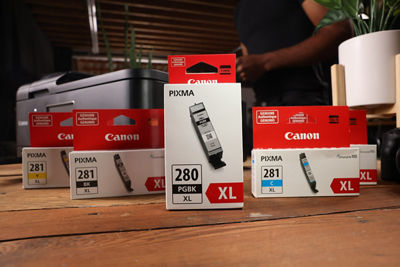
Printer Compatibility
Be sure and check the manual that came with your printer to confirm that it uses ink. Ink is used in inkjet printers. An example of a popular, at-home inkjet printer is the Canon PIXMA TS7720. This wireless1, three-in-one printer can print, copy and scan up to 15 black and white or 10 color images per minute5. It offers automatic two-sided printing, so it may even save paper as you go.
Printing Process
An inkjet printer works by taking digital information and transferring it to a tangible, printed page using ink. First, when you select “print,” your computer or personal device sends instructions to your inkjet printer. Then, microscopic nozzles called jets move rapidly across the page, spraying liquid ink as they go. The ink could be black and white or color, depending on your printer and your needs. Rollers move your paper through the printer as the ink is distributed, delivering the final product to your output bin or tray as you wait. (For a more detailed description, visit Canon’s page on How Inkjet Printers Work).
Print Quality
Printing with ink can deliver vibrant colors and sharp images. Inkjet printers are a great choice for people who print photos and graphics. Another benefit of this type of printer is it can print on a variety of materials. The Canon MegaTank PIXMA G3270 Wireless1 All-in-One Printer is an excellent example: it supports a variety of media types and sizes and can print on envelopes, glossy paper, photo paper, cardstock and more, up to 8.5 inches by 47 inches.

Printing Speed
Speed is often flagged as one of the drawbacks of inkjet printers. And, while it’s true that laser printers can be faster, there’s a lot of variability among different inkjet models. The Canon MegaTank MAXIFY GX7021 Wireless1 Home & Office All-in-One Printer, for example, can print up to 24 black-and-white pages per minute (and up to 15 in color)5. Still, inkjet printers may be a better fit for individuals or offices that don’t need a high volume of output quickly.
Durability
Ink can be more or less durable depending on what kind you purchase. Dye inks, for example, may fade more quickly, while pigment inks may last longer and be more resistant to the deteriorating effect of sunlight. In addition, compared to toner, ink is water-based, so it may be more sensitive to smudging and smearing if a printed page comes into contact with excess moisture, or if the page isn’t given enough time to dry before handling. In addition, when purchasing ink and an inkjet printer, you should consider how much printing you’ll need to do. MegaTank printers, like the Canon PIXMA G3270 Wireless1 Printer, can print up to 6,000 pages in black and white and up to 7,700 pages in color using a single set of inks6.
Ideal Use Cases
If you’re considering purchasing an inkjet printer, make a list of your priorities. Because these printers are so adept with graphics and can use so many different types of paper products, they’re frequently the printer of choice for photographers, artists and businesses that rely on high-quality imagery and graphics. In addition, because you can often find compact inkjet printers at lower prices, they tend to be the go-to option for many at-home users and home-officer dwellers.
To learn more about ink and inkjet printers, visit Canon Printer Ink Cartridges.
Want to learn more about some of the top choices for inkjet printers? Here are three popular offerings from Canon:
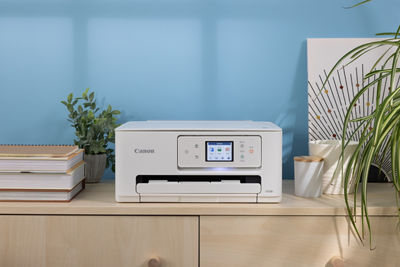
Canon PIXMA TS7720 Wireless1 All-in-One Printer
- Wireless1 3-in-1 (Print | Copy | Scan)
- 15 (BW) / 10 (Color) Images Per Minute (ipm)5
- 100-Sheet Paper Cassette + 100-Sheet Rear Tray
- Auto 2-sided Printing
- 2.7" LCD Touchscreen for easy navigation
- Stable and reliable connection with Dual Band Wi-Fi (2.4GHz or 5GHz)
- Save up to 70% on the cost of printing with PIXMA Print Plan
- ENERGY STAR®3, EPEAT Silver
- 1 Year Warranty4
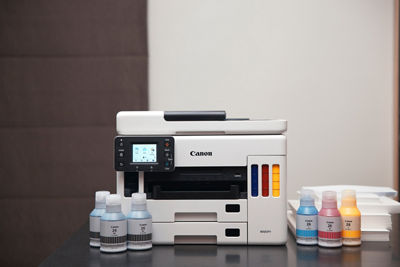
Canon MegaTank MAXIFY GX7021 Wireless1 All-in-One Printer
- Wireless1 4-in-1 (Print | Copy | Scan | Fax)
- Integrated Ink Tanks - Up to 6,000 pages BW / 14,000 pages6 Color included!
- 24 / 15.5 ipm5
- Pigment Ink for Durable Documents
- (2) 250 Sheet Cassettes + 100 Sheet Rear Tray
- Auto 2-Sided Printing
- ENERGY STAR®3, EPEAT Silver
- 3 Year (or 80,000 Sheet) Warranty4
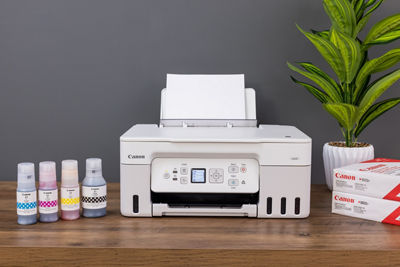
Canon MegaTank PIXMA G3270 Wireless1 All-in-One Printer
- Wireless 3-in-11 (Print | Copy | Scan)
- Integrated Ink Tanks - Up to 6,000 pages BW / 7,700 pages Color included!6
- 11 / 6 ipm5
- 100 Sheet Rear Tray
- Single-sided Printing
- ENERGY STAR®3, EPEAT Silver
- 1 Year Warranty4
- Wireless printing requires a working network with wireless 802.11b/g or 802.11n capability. Wireless performance may vary based on terrain and distance between the printer and wireless network clients.
- Print speed is based on internal testing. Print speed may vary, depending on the number of copies selected as well as the settings for size, type, and orientation of paper.
- As an ENERGY STAR® Partner, Canon U.S.A., Inc. has certified this printer as meeting the ENERGY STAR energy efficiency criteria through an EPA-recognized certification body.
- Warranty program is subject to certain conditions and restrictions. See warranty card for details.
- Document print speeds are the averages of ESAT in Office Category Test for the default simplex mode, ISO/IEC 24734. Print speed may vary depending on system configuration, interface, software, document complexity, print mode, page coverage, type of paper used etc. See www.usa.canon.com/ipm for additional details.
- Page yield of included ink bottles used for initial setup is lower than the replacement ink bottles, as a certain amount of ink is consumed to fill into the print head during setup (charging the print head initially). Page yield is the estimated value based on Canon individual test method using the ISO/IEC 24712 chart and continuous printing simulation with the replacement ink bottles after initial setup. Page yield of color inks is an average yield of cyan, magenta and yellow inks combined. Page yield varies significantly depending on content printed, ink levels maintained in all four reservoirs, and other factors. Up to 6,000 (black)/7,700 (color) printed page yields are approximate using `default printing mode’, up to 8,300 (black)/7,700 (color) printed page yields are approximate using `economy printing mode’ via Windows/Mac OS driver or printer copy setting, based off document pages printed. A full set of MegaTank GI-21 ink bottles (pigment black, cyan, magenta, yellow) is equivalent to 30 each standard capacity Black (PG-260) and Color (CL-261, composed of cyan, magenta and yellow) ink cartridges sold individually based on print yield. Ink value savings based on MSRP (USD) of stated equivalent ink cartridges as of November 2023.


